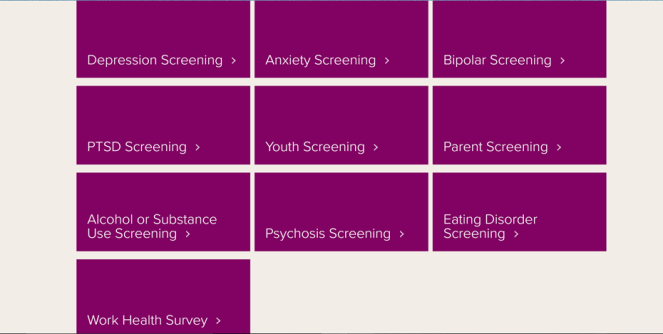Being able to detect and treat mental disorders early in childhood has become increasingly possible with as technology advances. Early detection has been aided by the ability to quickly and widely distribute screening tool. The process for administering these tools as well as the knowledge of what to do when mental health issues are present can now be taught over the internet. Mental health expertise can be called upon by cellphone, email, or video chat from anywhere. Electronic medical records make it easier than ever for pediatricians to track changes over time and interventions that have been attempted. However, the advantages of integrating technological innovations into caring for the mental health of children is accompanied by its own set of risks.
Access to Screening Tools
As I’ve discussed in previous posts different initiatives to provide early detection and treatment of mental and developmental disorders in children make tools such as screening tools available to providers and others to assist with early detection. Increasingly these tools are being distributed through these organizations’ websites. For example, Mental Health America provides consumers with access to easy to use screening tools including one that children ages 11-17 years old can use and another that parents can use if they are concerned about their children1. These screenings can be found at: http://www.mentalhealthamerica.net/mental-health-screening-tools

© Copyright Mental Health America, March 30, 2017
Birth to 5: Watch Me Thrive provides pediatricians and early childcare caregivers and teachers with a compendium of the appropriate screening tools for early childhood on their website2. It provides information on validity and reliability of these tools, who can administer them, costs, and where to learn how to administer them. In addition, there are links to publishers’ websites with more information on these tools as well as how to order them.
Another great resource for a list of screening tools that are readily available is this website: https://depts.washington.edu/dbpeds/Screening%20Tools/ScreeningTools.html
Clearly, there are wide variety of screening tools and methods for conveniently accessing them over the internet. However, just because someone can get a hold of one of these tools doesn’t mean they have the training to use the tool appropriately and interpret the results accurately. Fortunately, technology is helping us to overcome this barrier too. For simpler tools, often it is possible to provide instructions over the internet through files such as PDFs, however, other tools are more complicated to administer and interpret. Even when the tool may be easy to use what to do in response to positive results can be far more complex. Technology provides a potential solution for this issue in the form of online trainings.
Availability of MH Training Online
Several publishers provide training on how to use their screening tools through online webinars. For example, Sensory Processing Disorder University provides a webinar to teach about the administration and interpretation of FirstSTEp screening tool through their website3. Organizations interested in the welfare of children provide webinar training as well. For instance, pediatricians can find training for managing depression in their patients on the American Academy of Pediatrics website4. This not only includes an explanation for using screening tools for depression and how to interpret them but other issues surrounding treating depression in the pediatric population. Being able to provide these training online allows these trainings to be provided to anyone across the country who has internet access without the cost of travel for either the presenters/trainers or the attendees.
For school nurses, the American Psychiatric Nurses Association (APNA) is working with the National Association of School Nurses (NASN), to provide a continuing education course online called Transitions in Practice Certificate Program5. This training discusses evidence-based approaches to providing care to children with mental health issues including risk assessment and therapeutic engagement. In cases where the school nurse needs to consult a mental health expert or communicate with a child’s mental health provider or pediatrician about concerns, advances in communication technologies can be of further use.
Communication with Experts

School nurses use communication technologies to communicate with mental health, providers, and pediatricians, who are not normally readily available due to time constraints or distances. Internet tools such as video chat or email provide means of communication to seek guidance if they have particularly challenging cases or questions about care. The ability to maintain patient or student privacy while using these means of communication can be particularly challenging. However, it is a necessity according to HIPAA, which requires the protection of personal health information from release to unauthorized persons6. This includes unintentional exposure of information being maintained or transmitted electronically such as in the case of a data breach. This is a more common problem than you may think: 1 in 4 consumers of healthcare in the U.S. have had their personal medical information stolen in data breaches of electronic systems6. It is important to remain vigilant when using electronic communication to talk about patients and to consider the services you use when making these communications. For instance, while Gmail is secure and encrypted other email service providers are more prone to being hacked and may not be encrypted. The same is true of video chatting services, healthcare professionals who use these services must ensure that they securely transfer information.
1Mental Health America (2017). Mental health screening tools. Retrieved from http://www.mentalhealthamerica.net/mental-health-screening-tools
2U.S. Department of Health and Human Services (2014). Birth to 5: Watch me thrive! A compendium of screening measure for young children. Retrieved from https://www.acf.hhs.gov/sites/default/files/ecd/screening_compendium_march2014.pdf
3Sensory Processing Disorder University (2016). Course catalog. Retrieved from http://spduniversity.spdstar.org/diweb/catalog/c/325/n/2
4American Academy of Pediatrics (2016). Don’t let it get you down! Managing depression in primary care. Retrieved from https://pediatriccare.solutions.aap.org/MultimediaPlayer.aspx?multimediaid=12308126
5Burtka, A.T. (2017). Nurses group partner to better address students’ mental health issues. Retrieved from http://associationsnow.com/2017/03/nurses-groups-partner-better-address-students-mental-health-issues/
6Estopace, E. (2017). 1 in 4 US consumers had experienced healthcare data breach. Enterprise Innovation, Retrieved from http://login.ezproxy1.lib.asu.edu/login?url=http://search.proquest.com.ezproxy1.lib.asu.edu/docview/1873063944?accountid=4485

I thoroughly enjoyed reading your post this week, as well as your past posts. I appreciate that you are taking on such an important topic. Just the other day I saw an ELEVEN year old boy who had to be hospitalized under strict 1:1 observation due to severe suicidal ideation and even an attempt to hurt his mom as she tried to keep him from hurting himself. This is a child who has struggled with anxiety and depression since a very young age, yet he has been unable to get the treatment that he needs due to a variety of obstacles and barriers (and definitely not because of a lack of effort on the part of his parents). It is a heartbreaking story, yet one that we hear all too often these days.
I am glad that you shared so many potential resources for mental health assessment of children, as well as pointed out the inherent challenges with the technological advancements as these tools become more complex and are made more and more available not only to trained healthcare providers, but also to inexperienced professionals and even parents or the general public. I am excited by the advancement of these tools and the increased availability of them, but I admit I am also concerned by the potential challenges that can occur when they are administered and interpreted by persons not properly trained in their use and interpretation. Have you come across any studies or literature that speaks to this concern, or the challenges with tool administration and interpretation by non-mental health professionals? Even as general practitioners, we aren’t always properly trained in mental health assessment of children. That being said, we have made significant strides in this area due to the recent initiatives and advocacy geared directly toward the improvement of children’s mental health. I had mentioned on another blog the various assessment tools made available by the National Association of Pediatric Nurse Practitioners (NAPNAP), as well as the parent handouts and informative brochures regarding children’s mental health that are posted on their website. I also know there are some self-administered tools that adolescents have been able to use to “self-screen” for anxiety and depression, which is a unique way of empowering the child to seek help if it is needed. As you duly noted, the technological advancements and innovative approaches that the world wide web has enabled us to take with mental health issues is quite impressive.
You also brought up some excellent points about the challenges with data sharing and privacy. Not only does email pose challenges to data breaches, but video calls can easily be overheard if the person making/accepting the call is not in a private location (this is especially true in a school setting where space is limited!), and text messages sent between providers with sensitive patient information can easily be intercepted, seen by someone with “wandering eyes,” or even inadvertently sent to the wrong number/person – something we all know can’t be “undone” once it is out there. Yet I do believe that with the proper precautions and security measures, the technological advancements and innovative tools being developed have the potential to greatly improve the mental health services we can provide to our children, and starting at a much earlier age than ever before.
Thank you again for tackling such an important topic!
References:
Melnyk, B. (2013). A Practical Guide to Child and Adolescent Mental Health Screening, Early Intervention, and Health Promotion (2nd ed.). New York, NY: National Association of Pediatric Nurse Practitioners.
National Association Pediatric Nurse Practitioners. (2016). Mental health guide handouts. Retrieved from https://www.napnap.org/ProgramsAndInitiatives/MentalHealth/MentalHealthGuide/MentalHealthGuideHandouts.aspx
LikeLike
I enjoyed your blog this week! Thank you for posting. Pediatric mental health is a delicate and much needed specialty in the Phoenix area.
One of my good friends graduated from ASU as a Mental health nurse practitioner in 2010. For years she has seen patients via skype, text messaging, and other methods of telemedicine. When she first started seeing patients in her office via skype, I thought about how all those patients she was able to reach in the rural areas that were not able to obtain mental health care for themselves near them.
Another one of our cohorts is trying to put together a pilot office for various specialties to visit her rural health area once a month. With the ability to see patients other than in person, the sky is the limit.
Companies like dial a doctor (http://dial-a-doctor.com.au/), Heal (https://heal.com/), and Page (https://pager.com/) are changing the way healthcare is performed by taking old school ways and applying new school technologies. These companies are all over the world and are taking doctors back to homes by answering house calls with new technological advancements and methods. They are fast becoming the uber of healthcare if you will.
“Dr. Renee Dua, a founder of Heal, told The New York Times. Key among those old-school techniques are home or office visits, where doctors not facing the high-volume pressure of insurance billing can actually spend the time to talk to patients, and, in the case of a home visit, notice things they might miss in a 15-minute office consultation.” (1)
How much more effective would our interventions of critical mental health patients be if providers and practitioners were able to see these patients in their home environments with house calls? We might be a long way from that or it could happen right under our noses! Of there are limits to what practitioners can do at a house call, but it sure has to be better than dialing 911, waiting for someone to show up, get to the hospital, have an evaluation, and then wait hours in an ER to be admitted or discharged. Imagine how much money we could save the healthcare industry.
Just something to think about!
(1) http://www.csmonitor.com/USA/USA-Update/2015/1203/Uber-of-healthcare-lets-you-dial-a-doctor.-Are-house-calls-back
LikeLike
Are there any technologies out there that are being used to assess and evaluate kids or help facilitate functioning like communication with non-verbal kids who experience Autism? I liked that you framed the use of assessment tools as technology as well, as they change an improve so does the means to improve early identification of mental health issues that could also improve their outcomes and impact through the life span.
LikeLike
That is an excellent point about considering technologies that assist children who have disorders like autism. Examples, such as Indi, a symbol-based communication tool on a tablet (http://www.mayer-johnson.com/indi) and the use of wearable tech such as Google Glass to assist with emotion reading, demonstrate how technological innovations can benefit children with develop mental disorders early in life.
LikeLike